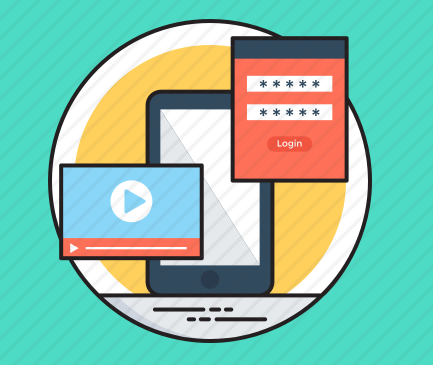gui设计模式
GUI:图形用户界面 (GUI: Graphical User Interface)
GUI is an abbreviation of Graphical User Interface. It alludes to an interface through graphic components that enable one to interrelate with electronic devices like computers and tablets. To show information, it uses icons, menus and other graphical portrayals in a specific way, as averse to text-based instructions. The graphic components allow users to give instructions to the computer and by the use of a mouse or other input devices choose services preferably.
GUI是“图形用户界面”的缩写 。 它通过图形组件暗示了一种界面,使人们能够与诸如计算机和平板电脑之类的电子设备相互关联。 为了显示信息,与基于文本的说明相反,它以特定方式使用图标,菜单和其他图形描述。 图形部件允许用户向计算机给出指令,并且优选地通过使用鼠标或其他输入设备来选择服务。
Under a GUI, the programs which run has a particular order of a set of graphic components so these programs a user can use without taking the training of new commands, after taking training in a particular interface. Xerox 8010 Information system was the original GUI-centric computer operating model. It was designed and created by Alan Kay, Douglas Engelbart and their partners at Xerox PARC. Till 2014, the highly demanded GUIs are Microsoft Windows and Mac OS X. And, if we discuss mobile devices, then Apple's IOS and Google's Android Interface are the extensively used GUIs.
在GUI下,运行的程序具有一组特定顺序的一组图形组件,因此,在经过特定界面的培训之后,用户无需经过培训即可使用这些程序。 Xerox 8010信息系统是最初以GUI为中心的计算机操作模型。 它是由Alan Kay,Douglas Engelbart及其合作伙伴Xerox PARC设计和创建的。 到2014年为止,要求很高的GUI是Microsoft Windows和Mac OSX。而且,如果我们讨论移动设备,则Apple的IOS和Google的Android Interface是广泛使用的GUI。

Image source: https://www.iconfinder.com/icons/3337153/
图片来源:https://www.iconfinder.com/icons/3337153/
GUI的基本组件 (Basic Components of a GUI)
Pointer: On the display screen, it is a marker that pop-ups. It can proceed to choose commands and objects.
指针 :在显示屏上,它是一个弹出的标记。 它可以继续选择命令和对象。
Pointing device: On the display screen, it enables a user to shift the pointer and choose objects, e.g. a mouse or trackball.
指点设备 :在显示屏上,它使用户可以移动指针并选择对象,例如鼠标或轨迹球。
Icons: On the display screen, it alludes to small images that constitute commands, files, windows etc. By the use of pointer and pointing device, a user can implement these commands.
图标 :在显示屏上,它暗示构成命令,文件,窗口等的小图像。通过使用指针和定点设备,用户可以实现这些命令。
Desktop: It is the display screen that holds within the icons.
桌面 :图标中包含的显示屏。
GUI的优点 (Advantages of GUI)
It enables a user to set more information and data inside a program.
它使用户可以在程序内部设置更多信息和数据。
The graphics enable users to use intricate programs with considerable effortlessness.
图形使用户可以毫不费力地使用复杂的程序。
A user does not require editing configurations by hands, which saves a lot of time.
用户不需要手动编辑配置,从而节省了大量时间。
A user can simply memorize the tasks just through point-and-click.
用户只需单击即可简单地记住任务。
With a point-and-click interface, it aids in designing and developing user-friendly software.
通过点击界面,它可以帮助设计和开发用户友好的软件。
GUI的缺点 (Disadvantages of GUI)
The tasks on which a user operate some commands in command line tools like MS DOS takes additional time to complete in GUI.
用户在命令行工具(如MS DOS)中对某些命令进行操作的任务需要花费更多时间才能在GUI中完成。
It consumes a large amount of time to create and design an excellent looking interface.
创建和设计外观精美的界面会花费大量时间。
Many GUI's consumes a large amount of memory resources which makes an operating system or device very slow.
许多GUI消耗大量内存资源,这会使操作系统或设备非常慢。
Testing and execution consumes a large amount of time.
测试和执行会消耗大量时间。
翻译自: https://www.includehelp.com/dictionary/gui-full-form.aspx
gui设计模式







 GUI(图形用户界面)提供了一种通过图标、菜单等图形组件与电子设备交互的方式,降低了用户使用复杂程序的难度。其优点包括增加信息显示、简化操作,而缺点则涉及执行效率、设计成本和资源消耗。了解GUI的基本组件和其在不同操作系统中的应用,对于提升用户体验至关重要。
GUI(图形用户界面)提供了一种通过图标、菜单等图形组件与电子设备交互的方式,降低了用户使用复杂程序的难度。其优点包括增加信息显示、简化操作,而缺点则涉及执行效率、设计成本和资源消耗。了解GUI的基本组件和其在不同操作系统中的应用,对于提升用户体验至关重要。

















 被折叠的 条评论
为什么被折叠?
被折叠的 条评论
为什么被折叠?








